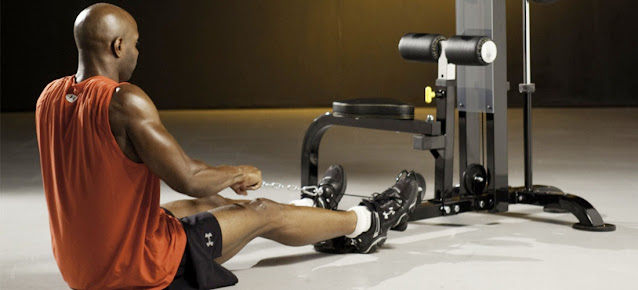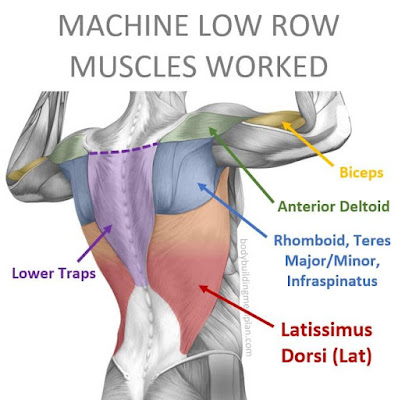What is the low row?
Rows are a fantastic way of targeting muscles in the back, especially the upper traps. They're a relatively easy compound movement that you can use at the end of a workout to really challenge your lats, upper back and abs.
The row is a single joint movement (meaning the exercise works on just one joint), and, in addition to being great for the major back muscles, it is also ideal for targeting the muscles around your scapula.
Rows are in fact an old school weightlifting exercise, and they're especially popular among cross-fitters these days.
How to do a low row
Sit down on a row machine with your feet on the front platform or crossbar provided keeping your legs slightly bent at the knees. (Alternatively, you can sit down on a flat bench with one dumbbell on either side of you and your feet firmly planted on the floor).
Bend over as you keep the natural alignment of your back and grab the bar. Keep your shoulders retracted and pull back until your torso is at a 90-degree angle from your legs.
Your back should be slightly arched and your chest should be sticking out. You should be feeling this exercise in your back muscles, especially the lats (latissimus dorsi).
The forearms should do no other work except for holding the bar; therefore do not try to pull the bar using the forearms.
After a second contraction at the top, slowly go back to the original position while breathing in. Exhale as you perform this step.
Tip: Make sure that you do not go all the way down to avoid unnecessary stress on your back. Go only until you feel a stretch on your lats (as shown in the illustration above).
Which muscles are worked with a low row?
Rows are a compound exercise that work the muscles of the back. The major muscles that are worked are the lats, rhomboids, traps and biceps.
The Lats
The lats are a large muscle that covers the side of your body from shoulder to hip and they help pull your arm down toward your torso.
Well developed lats give your back real width and the much sought after V taper. Many people prefer pulldowns for lat development but get real thickness and width, there is no better exercise than a row.
The Rhomboids
The rhomboids are located between your shoulder blades and they help move your shoulder blades together by pulling them back.
There is probably no better exercise than a low row for developing the rhomboids. At the top of the movement, you can really squeeze the muscle and feel the connection.
The Traps
The traps are located at the top of your shoulders and they help stabilize the upper body while moving it through space. Whilst shrugs are great for adding height to your traps, the low pulley row is the best movement for thickness and mass.
The Biceps
The biceps are located on the front of your upper arm and they help bend your elbow when you lift something with one hand (like holding a dumbbell). Biceps are a secondary mover here as they are just assisting the back muscles. Regular, heavy rows will add mass and strength to the bicep.
What is a row machine?
Row machines provide assistance with your rows, so you can exercise safely and effectively.
These chairs support your back while you perform the exercise, while also ensuring that you still get the full range of motion benefits.
The exercise involves sitting down on the machine, placing your feet against the pads, grabbing the handle with your palms facing in toward you, and pulling it towards your body until it touches underneath your rib cage.
Once you've reached this point, you extend your arms out again to return to the starting position.
It's really important to keep your back flat and not arch during this exercise—you want to avoid putting unnecessary strain on your spine.




